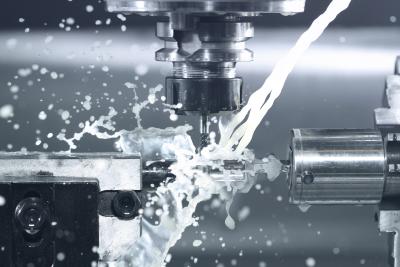
Regulatory constraints, but also operator well-being, encourage industrials to develop increasingly neutral solutions for the working environment. For many years, CONDAT has been committed to finding healthier products and innovates by offering soluble lubricants based on renewable, boron-free raw materials without formalin, chlorine, DEA, DCHA or silicone releasing agents. More recently, CONDAT distinguished itself with an international automotive sector group by supplying an amine-free, high performance cutting fluid with a reduced health footprint: POLYBIO 650 ABF.
Amines are nitrogenated compounds derived from ammonia by the replacement of one or more hydrogen atoms by carbonated groups. The number of hydrogen atoms n linked to nitrogen, defines the amine class. There are 4 categories:
- Primary amines
- Secondary amines (for example: DEA and morpholine)
- Tertiary amines
- And quaternary amines
DEA (Diethanolamine) can be identified as the cause of various health issues for overexposed workers. Indeed, DEA can react with the nitrites/nitrates contained in water and can form a nitrosamine that is classified as carcinogenic in Europe. Other amines used in cutting fluids can also result in stable carcinogenic nitrosamines. This is the case for secondary amines. In Germany, the application of the TRGS 611 standard guarantees the use of cutting fluids that are free of carcinogenic nitrosamines. The R451 French health service recommendation also requests to avoid amines that generate carcinogenic nitrosamines.
To support an automotive aluminum part milling specialist, CONDAT offered a solution to recurring dermatitis issues reported by several operators: POLYBIO 650 ABF oil. Thanks to its specific fully amine-free formulation and its low pH, POLYBIO 650 ABF considerably reduces skin irritations risk.
Furthermore, the absence of amines in the milling bath provides additional comfort of use to operators by limiting the spread of ammonia odours released by the growth of bacterial strains.
In the automotive industry, on leaving the aluminium foundry shop floors, rough parts are milled and the tapping, drilling and milling operations can be especially difficult. In this sector, end users routinely work with series 40000 alloys with silicon additives such as 42200 (AlSi7Mg), 43200 (AlSi10Mg) or 46500 (AlSi9Cu). The high silicon content alloys (up to 12 percent) can cause extensive abrasion wear to tools. In these conditions POLYBIO 650 ABF’s high lubricating power makes it possible to increase tool service life by 10 to 15 percent, depending on the application. Tapping and torque tests clearly illustrated the POLYBIO 650 ABF enhanced performance compared to many competitor products. The tapping and torque test are used to make a comparative study of the forces required for tapping by deformation or removal of filings under iso-conditions.
Machining these aluminium alloys generates microscratches on the parts and difficulties in keeping to exact measurements. The result is random roughness that only high lubrication can mitigate. POLYBIO 650 ABF’s lubricating power provides a solution to this problem by reducing roughness. This lubricating power significantly improves surface conditions: the parts are shinier and have a “mirror” effect.
During production, lubricant losses can be significant and top-ups made daily to keep the bath effective. These losses have several causes, in particular the lubricant adherence to the part, the filings, and the evaporation of the water. POLYBIO 650 ABF’s detergency and wettability make it possible to reduce the amount of oil on the parts and filings, thereby reducing lubrication consumption by a significant reduction in top-ups.
When POLYBIO 650 ABF was developed, regular on-site visits and test monitoring provided the CONDAT team of engineers direct exchanges with operators. This extensive support made it possible to examine skin tolerance issues, odour issues, and also to check the baths on each visit. The after-sales department and the adjustment of top-up rates optimized consumption and generated increased productivity.
Contact Details
Related Glossary Terms
- alloys
alloys
Substances having metallic properties and being composed of two or more chemical elements of which at least one is a metal.
- cutting fluid
cutting fluid
Liquid used to improve workpiece machinability, enhance tool life, flush out chips and machining debris, and cool the workpiece and tool. Three basic types are: straight oils; soluble oils, which emulsify in water; and synthetic fluids, which are water-based chemical solutions having no oil. See coolant; semisynthetic cutting fluid; soluble-oil cutting fluid; synthetic cutting fluid.
- gang cutting ( milling)
gang cutting ( milling)
Machining with several cutters mounted on a single arbor, generally for simultaneous cutting.
- milling
milling
Machining operation in which metal or other material is removed by applying power to a rotating cutter. In vertical milling, the cutting tool is mounted vertically on the spindle. In horizontal milling, the cutting tool is mounted horizontally, either directly on the spindle or on an arbor. Horizontal milling is further broken down into conventional milling, where the cutter rotates opposite the direction of feed, or “up” into the workpiece; and climb milling, where the cutter rotates in the direction of feed, or “down” into the workpiece. Milling operations include plane or surface milling, endmilling, facemilling, angle milling, form milling and profiling.
- tapping
tapping
Machining operation in which a tap, with teeth on its periphery, cuts internal threads in a predrilled hole having a smaller diameter than the tap diameter. Threads are formed by a combined rotary and axial-relative motion between tap and workpiece. See tap.
- tolerance
tolerance
Minimum and maximum amount a workpiece dimension is allowed to vary from a set standard and still be acceptable.
